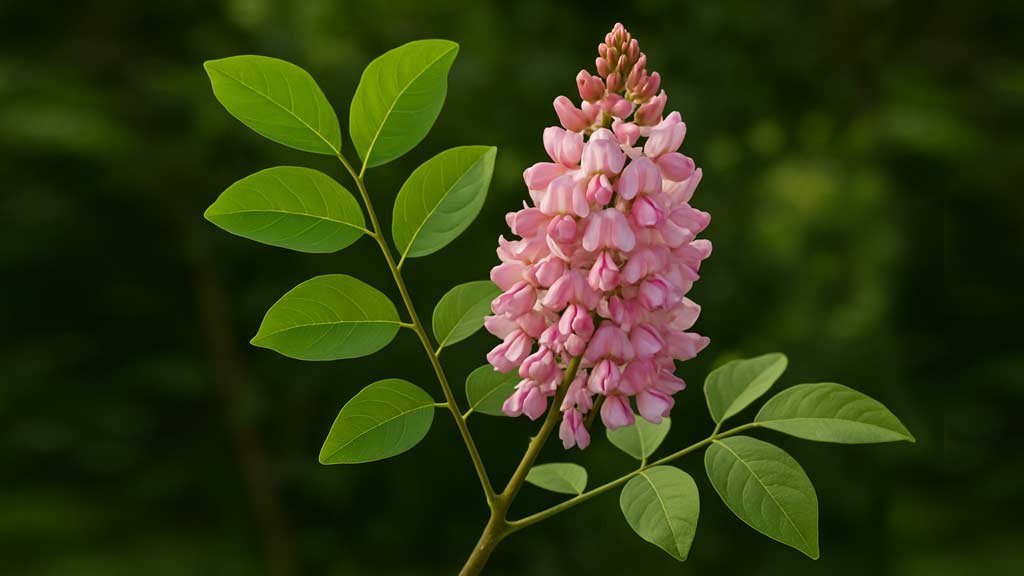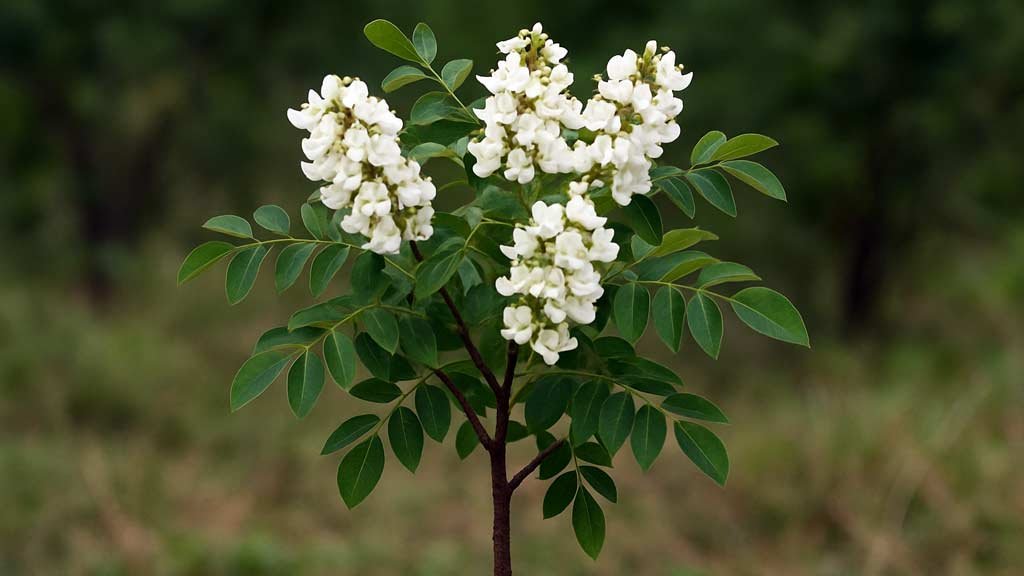A Tree with a Story
Jamaican dogwood isn’t the type of plant you stumble across in a common kitchen garden. Its Latin name, Piscidia piscipula, already hints at something unusual. In its native Caribbean and Central American range, people used the bark and leaves to stun fish. That’s right—drop parts of this tree into water, and the fish would slow down enough to catch by hand. Nature’s practical chemistry at work.
Over time, though, healers discovered that Jamaican dogwood had a knack for working inside the human body too—especially when it came to pain, restlessness, and broken sleep. Unlike some of the gentler teas we might sip before bed, this herb carries a stronger, almost solemn reputation. It’s calming, yes, but it’s also powerful.
And that’s part of what makes it fascinating.
Table of Contents
What Makes Jamaican Dogwood Unique
Most herbs known for relaxation—like chamomile or lemon balm—offer a soft landing. Jamaican dogwood is more like a weighted blanket. Its compounds interact with the nervous system in a way that slows racing thoughts and eases physical tension.
The bark contains isoflavonoids and rotenoids, natural chemicals that explain both the fish-stunning tradition and the plant’s sedative qualities. People once looked at it almost as a natural alternative to pharmaceutical painkillers, long before modern medicine developed synthetic options.
A quick note: not every plant with “dogwood” in its name has the same properties. The Jamaican version is unique; don’t confuse it with the ornamental flowering dogwoods you see in parks or temperate forests. Those look pretty in spring but won’t calm your nerves.
A Pain-Soothing Ally
One of the most documented uses of Jamaican dogwood is for pain. Herbal practitioners have leaned on it for:
- Neuralgia, that sharp, electric kind of nerve pain.
- Menstrual cramps that grip and twist in the lower belly.
- Headaches that throb in time with your pulse.
- Musculoskeletal pain, especially the kind that won’t let you fall asleep.
Instead of numbing sensation altogether, Jamaican dogwood seems to shift the body’s response to pain, softening the edges. Imagine turning down the volume of an irritating background noise—you can still hear it, but it doesn’t dominate the room anymore.
That said, this isn’t a plant you casually toss into a tea blend. Traditional herbalists often prepared tinctures or decoctions, carefully measured and respected for their potency.
Jamaican Dogwood for Sleep
There’s a difference between feeling tired and actually falling asleep. Anyone who’s spent hours staring at the ceiling at 3 a.m. knows this too well. Jamaican dogwood has a reputation for helping people cross that line.
Its sedative action seems to quiet the nervous system. Muscles relax, thoughts slow down, and the body finds its way into a deeper rest. Some users describe the effect as a heavy calm—not groggy, but undeniably weighted.
It’s often combined with other herbs like valerian root or hops, which add their own layers of sleep support. Together, these plants form a gentle yet persuasive argument for rest when the body resists.
Traditional Uses and Folk Knowledge
In Caribbean communities, Jamaican dogwood wasn’t a casual household tea. Healers used it with intention, often for specific conditions rather than general wellness. Beyond pain and sleep, it was also applied externally for skin issues, bruises, or swelling.
There’s a rhythm to folk medicine: plants are tried, observed, and passed down across generations. If something worked, people remembered. Jamaican dogwood earned a steady place in that lineage.
At the same time, it was always handled with respect. Too much could overwhelm, and local traditions warned against reckless use. That caution still applies today.
The Science Behind the Bark
Modern research hasn’t caught up to the full depth of Jamaican dogwood’s traditional use, but some studies do confirm its sedative and antispasmodic effects. Extracts from the bark show activity that slows nerve firing and reduces muscular tension.
Scientists have noted its role in modulating GABA, one of the brain’s main calming neurotransmitters. This partly explains why people experience less anxiety and more restful sleep when using it.
Still, the scientific literature is thinner than for more popular herbs. Part of the reason may be that Jamaican dogwood isn’t cultivated as widely, and its potency has always made researchers cautious.
Safety, Dosage, and Considerations
Let’s be blunt: Jamaican dogwood isn’t for everyone. Pregnant women, breastfeeding mothers, and children should avoid it. Anyone taking prescription sedatives or painkillers should talk to a healthcare professional before even thinking about it.
Herbalists usually recommend tinctures in small, carefully measured amounts. The dried bark can be used in teas or decoctions, but the taste is bitter, and the effect is strong. Too much can cause nausea, dizziness, or worse.
So if you’re curious, think of Jamaican dogwood as a specialist tool rather than an everyday tonic. Respect is part of the practice.
Comparisons with Other Calming Herbs
How does Jamaican dogwood measure up against other well-known herbs?
- Valerian root: Both act as sedatives, but valerian is softer, more socially accepted as a “tea before bed” option. Jamaican dogwood feels heavier.
- Passionflower: Excellent for anxiety and circular thoughts. Jamaican dogwood leans more toward physical pain alongside sleep support.
- Chamomile: Gentle, floral, mild. Suitable for children. Jamaican dogwood is the adult-only cousin with stricter boundaries.
This contrast highlights Jamaican dogwood’s niche: when ordinary calming herbs don’t quite cut it.

Preparing Jamaican Dogwood
In traditional practice, the bark is the main part used. Methods include:
- Tincture: Alcohol extracts preserve and concentrate its active compounds.
- Decoction: Bark boiled slowly in water. The result is strong and bitter.
- Topical applications: Sometimes infused into oils or poultices for bruises or swelling.
Because of the potency, measuring matters. This isn’t a “pinch and pour” type of herb. If you don’t like the bitterness, tinctures offer a more palatable option.
A Plant with Personality
Every herb has a personality if you spend enough time with it. Chamomile is sunny and soft, lavender leans fragrant and motherly, while Jamaican dogwood is the quiet, serious one in the corner. It doesn’t invite everyone in. It waits until someone really needs it.
That sense of gravity is part of its charm. It’s a reminder that plants aren’t just passive background characters in nature. Some of them are forceful allies, asking for careful partnership.
Closing Thoughts
Jamaican dogwood isn’t the first herb you’d reach for if you can’t sleep after one too many espressos. It’s not the casual evening tea or the gentle lullaby. But for those who wrestle with pain that steals rest, or nerves that feel like live wires, it’s a plant worth knowing about.
Handled wisely, it offers something precious: relief deep enough to let the body rest and repair. It’s not a plant of everyday comfort—it’s a plant of moments, when nothing else seems to quiet the noise.
Article Sources
At AncientHerbsWisdom, our content relies on reputable sources, including peer-reviewed studies, to substantiate the information presented in our articles. Our primary objective is to ensure our content is thoroughly fact-checked, maintaining a commitment to accuracy, reliability, and trustworthiness.
- Duke, J. A. (2002). Handbook of medicinal herbs (2nd ed.). CRC Press.
- Foster, S., & Hobbs, C. (2002). Herbal medicine: From the heart of the earth. Botanica Press.
- Grieve, M. (1971). A modern herbal: The medicinal, culinary, cosmetic and economic properties, cultivation and folklore of herbs, grasses, fungi, shrubs & trees with all their modern scientific uses. Dover Publications. (Original work published 1931)
- New York Botanical Garden. (n.d.). Jamaican dogwood (Piscidia piscipula). In Plant Information Portal. Retrieved September 20, 2025, from https://www.nybg.org
- Phytotherapy Desk Reference. (2009). Jamaican dogwood (Piscidia piscipula). Churchill Livingstone Elsevier.
- U.S. National Library of Medicine. (2022). Jamaican dogwood. In MedlinePlus Herbs and Supplements. Retrieved September 20, 2025, from https://medlineplus.gov
- Williamson, E. M., Lorenc, A., Booker, A., & Robinson, N. (2013). Phytotherapy: Safety and quality. Elsevier Health Sciences.
- Zhao, J., Dasmahapatra, A. K., Khan, S. I., & Khan, I. A. (2012). Anti-inflammatory and analgesic activity of Jamaican dogwood (Piscidia piscipula) bark extract. Journal of Ethnopharmacology, 143(2), 556–561. https://doi.org/10.1016/j.jep.2012.07.028

